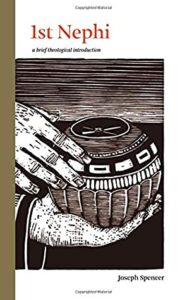 Review
Review
Title: 1st Nephi, a Brief Theological Introduction
Author: Joseph Spencer
Publisher: Neal A. Maxwell Institute for Religious Scholarship, BYU
Genre: Religious Non-Fiction
Year Published: 2020
Number of Pages:148
Binding: Paperback
ISBN: 978-0-8425-0007-4
Price: $9.99
Reviewed by Kevin Folkman for the Association for Mormon Letters
Joseph Spencer has written a book about theology in the Book of Mormon. In and of itself, that is not a remarkable statement. After all, Spencer has written other books and articles of a theological nature. Writing theology, though, implies theologians, people who spend their time doing systematic study and applying the tools of scholarship and reason to doctrine and scripture. In churches with a hierarchical structure, like the Roman Catholic or Anglican churches, theology is formalized in the idea of a magister, a group of ministers and scholars dedicated to codifying and defining essential theology and doctrine. Lacking such a magister, it could be argued that the General Authorities of the Church of Jesus Christ of Latter-day Saints fulfill that role, despite being made up primarily of professionals and businessmen. That hasn’t prevented an ad hoc magister of LDS scholars from emerging through academic institutions and independent publications. Such an informal LDS theology, mostly done by scholars outside the Church’s hierarchy, has the potential to generate tension in some church members. Resistance to the ideas of higher criticism and close textual readings of scripture has recently waned, however, in parallel with a more open approach to the Church’s history.
Given such a legacy, it is not surprising that theology in the Church is a developing concept. The rise of Mormon Studies programs at state and private universities, and at BYU with publications from the Religious Studies Center and the Neal A. Maxwell Institute for Religious Scholarship there, is beginning to shape that development. This year, the Maxwell Institute is publishing a series of “Brief Theological Introductions” on the Book of Mormon, coinciding with the Come Follow Me curriculum on the Church’s foundational scripture. 1st Nephi, by Joseph Spencer, is the first in this series of compact paperback volumes that in many ways resemble the Oxford University Press Very Short Introduction series both in format and style. The series editors make it clear that prophets and apostles fill the unique role of “declaring [the Church’s] definitive official doctrines,” but “invite Latter-day Saints to discover additional dimensions of this treasured text,” and engage each book in the Book of Mormon’s theology on its own terms. [Introduction, p viii]
Taking 1st Nephi as his subject, Spencer has the interesting task of a close reading of the “…book we know best,” the entry hall to the Book of Mormon that everyone reads first, before “…we stop reading entirely or because we stop reading attentively.” [p 2] We’ve all heard the jokes about a pocket Book of Mormon in a soldier’s breast pocket stopping a fatal bullet, because we all know “nothing can get through 2nd Nephi.” However, Spencer points out that the familiarity of 1st Nephi works in his favor in drawing out the theology contained there. We know the stories, and we are comfortable with Nephi’s account, the lengthiest and most sustained first person narrative in the entire Book of Mormon. Spencer uses his first three chapters to explain the structure of Nephi’s account and the overarching theme of the restoration of Israel that the book addresses.
Spencer first reminds that the original publication of the Book of Mormon contained fewer and longer chapters, and an absence of numbered verses. By using the seven chapters of the original Book of Mormon 1st Nephi, Spencer points out how Nephi plots his narrative to highlight “…the pair of prophetic texts in the book’s second half: Nephi’s visionary expansion of his father’s dream…and the block of Isaiah’s prophecies.” It is in these two sections that Spencer finds the theme of restoring scattered Israel and the promises of the Abrahamic Covenant. Spencer claims that these are the “plain and precious parts” foreseen by Nephi as being lost from Christianity’s current view of the Bible with its New Testament emphasis. [p 35]
For me, the most compelling messages of Spencer’s book are the discussions of the problem areas of 1st Nephi: Nephi’s killing of Laban, his relationship with his older brothers Laman and Lemuel, and his treatment of the women in his record. These three chapters make up the second half of Spencer’s theological exposition. In these chapters, Spencer draws a clear picture of Nephi’s imperfections and regrets over those failings, even as he recognizes Nephi’s growing prophetic gift.
 For as often as I have read the account of Nephi’s slaying of Laban, Spencer brought new subtleties to my understanding. He draws the reader’s attention to what many readers have often thought, that Nephi likely was an annoying and overbearing younger brother, despite his prophetic gift and steadfast obedience. Fixed on the idea that because of his obedience and faithfulness, Nephi was destined to rule over his brothers, he often acted immaturely. Spencer reminds us that after Laman’s polite first request of Laban to obtain the Brass Plates was turned down, Nephi’s subsequent attempt also fails spectacularly, resulting in the loss of much of the family’s financial wealth and an imminent threat of death for Nephi and his brothers. Hardly an auspicious start for a future prophet-leader. [p 76] It is only when Nephi goes back again a third time, somewhat humbled and being “…led by the spirit, not knowing beforehand the things which I should do,” that Nephi succeeds. [1st Nephi 4:6] Upon discovering the unconscious Laban, Nephi is constrained to take Laban’s life. The back and forth between Nephi and the Spirit suddenly became clearer to me. It’s as if the Spirit finally gets through to Nephi by saying “It’s not all about you, Nephi, it’s about your posterity and covenant Israel.”
For as often as I have read the account of Nephi’s slaying of Laban, Spencer brought new subtleties to my understanding. He draws the reader’s attention to what many readers have often thought, that Nephi likely was an annoying and overbearing younger brother, despite his prophetic gift and steadfast obedience. Fixed on the idea that because of his obedience and faithfulness, Nephi was destined to rule over his brothers, he often acted immaturely. Spencer reminds us that after Laman’s polite first request of Laban to obtain the Brass Plates was turned down, Nephi’s subsequent attempt also fails spectacularly, resulting in the loss of much of the family’s financial wealth and an imminent threat of death for Nephi and his brothers. Hardly an auspicious start for a future prophet-leader. [p 76] It is only when Nephi goes back again a third time, somewhat humbled and being “…led by the spirit, not knowing beforehand the things which I should do,” that Nephi succeeds. [1st Nephi 4:6] Upon discovering the unconscious Laban, Nephi is constrained to take Laban’s life. The back and forth between Nephi and the Spirit suddenly became clearer to me. It’s as if the Spirit finally gets through to Nephi by saying “It’s not all about you, Nephi, it’s about your posterity and covenant Israel.”
When it comes to Nephi’s relationship with Laman and Lemuel, Spencer points out that the older brothers were likely observant Jews, and with all their threats, never actually attempted to take the life of Nephi until the family separates in 2nd Nephi. Nephi judges his brothers harshly, it appears, and attempts to teach them things that they seem unable to understand. Nephi, writing from the perspective of some fifty years’ distance, “…repeatedly presents his young self as having moved too quickly, overstepped his bounds, or exhibited zeal without full knowledge.” It is a sadder, wiser Nephi writing from the vantage of old age who begins to acknowledge the shortcomings of his youth.
Finally, Spencer addresses the issue of the near-invisibility of women in 1st Nephi. Apart from his mother Sariah and Mary, the Mother of the Lamb of God, women in 1st Nephi are unnamed. One of the daughters of Ishmael becomes Nephi’s wife, the others the wives of Nephi’s brothers. They are never more than “daughters,” “women,” and “wives.” All we hear of them are as complainers about Lehi’s visions that have brought them to a harsh existence in the desert wilderness of the Arabian Peninsula. Rather than seeing them as whining and complaining victims, Spencer says, we should see them as trapped in gender roles defined by the culture of their times. Sariah complains to Lehi over her fear for the lives of her sons, sent back to a hostile Jerusalem. Ishmael’s daughter’s anxieties boil over after the death of their father in a strange and desolate wilderness. But as Spencer points out, their roles as wives and mothers put them in a unique position. “The social roles these women occupy,” Spencer writes, “position them to see things that go unseen by men.” These complaints about their situation and concerns are directed in both stories at Lehi, “…the visionary [that] can’t see what they can see.” [p 107] Unfortunately, whatever progress was made in understanding the roles played by women in the Book of Mormon by Nephi and his younger brother Jacob seems to get lost in the accrual of cultural affectations that limited the roles of the Book of Mormon women.
I feel it necessary to react to the physical format of the book. At eight inches in height and five in width, with a clear and appropriately sized font for the main text, the book is mostly easy to read. My reviewer’s copy came wrapped with a ribbon and an attached blank notebook of the same size and a complementary color scheme, apparently to use with this and with other volumes in this series. It is only in the use of explanatory footnotes, section headings, and some of the textual figures, that an orange colored font presented me with difficulties. They were difficult to read except in the brightest light. I know that I am older, but recent cataract surgery has rendered my vision to near its young adult acuity. In any kind of subdued lighting (I often read in bed at night), this colored font was hard to read. Fortunately, these occasions were few, and did not detract from the overall content.
I am continually surprised by the new concepts I learn both by continued reading of the Book of Mormon and recent scholarship that assists me in reading more closely and with increased comprehension. This first book in this series is no exception. My copy is heavily marked up and littered with sticky notes, pointing to new insights and areas for further study. “Brief” in the title does not mean insubstantial, if other volumes in this series are as challenging as this. Brief only means that it is accessible, and a starting point for further study and investigation. And Theology does not mean it is incomprehensible to the general reader. As an introduction, both to the Book of Mormon, and to this series as a whole, Spencer’s volume is a worthy effort for deeper understanding of the doctrines and theology of our foundational scripture.
FYI, I am submitting this to Keepapitchinin to use if Ardis wants to use it. Won’t know until I hear back from her.
